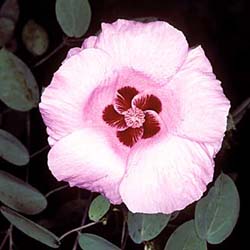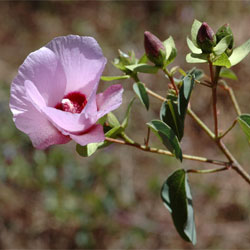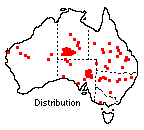Gossypium sturtianum
 |
 |
Sturt's Desert Rose
Gossypium sturtianum J.H.Willis
Gossypium sturtianum (Sturt's Desert Rose) occurs in the arid interior throughout the Northern Territory, Western Australia, South Australia, Queensland, New South Wales and Victoria. It is a member of Malvaceae, a cosmopolitan family with most of its 2000 species occurring in warm or tropical climates. Members of the cotton genus, Gossypium, are found in the arid regions of Mexico and Africa, with 12 species (9 native) occurring in Australia. G. sturtianum, a perennial shrub, has a life cycle of about 10 years. It grows as an erect, woody shrub to 3 metres tall and is charactarised by its Hibiscus-like flowers that appear throughout the year, with the most profuse flowering in late winter. It is also the floral emblem of the Northern Territory.
 Flowers
are solitary, mauve to lilac in colour with a dark red centre. The five petals,
arranged in a whorl, are ovate to triangular. Flowers may be up to 12 cm in
diameter, and are very attractive to honeyeaters. Multiple stamens surround
an undivided style, with red-orange anthers and the cream coloured pollen. Leaves
are alternate, ovate or rounded to 6 cm, folded along the main vein, entire
and dark green in colour. The leaves are strongly scented when crushed. Most
parts of the plant contain dark glands containing the toxic substance gossypol,
a feature of the genus. G. sturtianum differs in that its foliage contains
terpenoid glands, while its seed glands are non-functional prior to germination.
This species also contains a diminished version of the fluffy white seed covering
common to its genus and widely cultivated in commercial cotton.
Flowers
are solitary, mauve to lilac in colour with a dark red centre. The five petals,
arranged in a whorl, are ovate to triangular. Flowers may be up to 12 cm in
diameter, and are very attractive to honeyeaters. Multiple stamens surround
an undivided style, with red-orange anthers and the cream coloured pollen. Leaves
are alternate, ovate or rounded to 6 cm, folded along the main vein, entire
and dark green in colour. The leaves are strongly scented when crushed. Most
parts of the plant contain dark glands containing the toxic substance gossypol,
a feature of the genus. G. sturtianum differs in that its foliage contains
terpenoid glands, while its seed glands are non-functional prior to germination.
This species also contains a diminished version of the fluffy white seed covering
common to its genus and widely cultivated in commercial cotton.
Highly tolerant to drought, G. sturtianum occurs naturally in sandy or gravelly soils along dry creek beds, watercourses, gorges or rocky slopes. Although well adapted to hot dry climates, G. sturtianum will grow in humid areas given ample drainage and sun exposure. However, excellent soil drainage is important as the roots waterlog easily. It has been successfully grown in a soil mixture containing gravel with a trace amount of clay. It requires a sunny, well-drained position, and needs minimal irrigation. The Gossypium sturtianum var. sturtianum variety is frost-sensitive, whilst Gossypium sturtianum var. nandewarense is more resistant to light frosts. In colder regions, it is a good idea to position the plant near asphalt or the north side of a building to minimize frost damage.
G. sturtianum is easily propagated from either cuttings or seed. Cuttings should be taken from a free-flowering plant for best results. Prime seed collection time is February to April, and the ideal time for sowing is autumn or early spring. After collecting the grey-black seeds from a dehiscing capsule, soaking them in water for 16 hours prior to planting may facilitate germination. Seeds can then be spread over a propagating mix and covered with fine gravel. Seedlings should appear within 2-4 weeks.
Some degree of pest control may be required to curb aphid predation on the foliage. G. sturtianum is also quite sensitive to fungal infection, and should be planted in an area with free air circulation to prevent damage to leaves and stems. A lime tolerant species, G. sturtianum responds well to slow-release fertilisers with a low phosphorus content.
Text by Erin Kimball (2002 Student Botanical Intern)
Name meaning: Gossypium sturtianumGossypium - from the Latin gossypion referring to Pliny's cotton tree, Gossypium arboreum; sturtianum - after English explorer Charles Sturt (1795-1869), who first collected the plant. |
![An Australian Government Initiative [logo]](/images/austgovt_brown_90px.gif)

